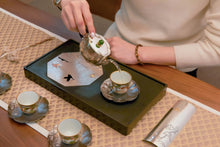
Silver kettles are precious for boiling water and precious for brewing tea. Lu Yu, the tea saint, said in The Classic of Tea that using silver kettles is too extravagant, but using porcelain kettles is not long-lasting, "If you use it constantly, it will eventually return to silver." This means that if you use it for a long time, you still have to use silver. At the same time, boiling water with a silver kettle is "silk-like silk"; brewing tea with a silver kettle can stimulate the fragrance of tea.
Today, Tongxinshe Teahouse brings you this "Begonia Bamboo Tea Silver Kettle" made by Mr. Hong Jike, the inheritor of intangible cultural heritage. The shape of the vessel is vivid and exquisite. It is made of 999 pure silver and is a rare tea table product. The more you use it, the more beautiful it is. It can be collected and passed down from generation to generation.
"Hongji Treasures" in Heqing, Yunnan, began during the Guangxu period of the Qing Dynasty. It has been passed down for five generations and still insists on using traditional kettle making techniques to make kettles. As the fourth-generation inheritor of "Hongji Treasures", Mr. Hong Jike is proficient in a variety of hand-made kettle making techniques.
The pot body is made of Begonia bamboo, and its shape and charm are integrated into the veins. The handle and spout are shaped like bamboo joints, presenting a sense of elegance and strength, which makes people think of bamboo when reading the pot, and taste bamboo when tasting tea.
——· Begonia bamboo tea silver pot ·——
• Size: D11xH6cm
• Capacity: 140ml
• Weight: 130g
• Material: Pure silver 999.9
• Craftsmanship: Pure handmade
The pot body adopts the most classic hammer eye pattern in silver pot craftsmanship. The neat and orderly hammer eye pattern makes the small pot look extraordinary, and it is even more loveable to play with it in your hands. The spout part adopts a streamlined design, which perfectly matches the curve of the pot body, and even the water is a soft curve.
Hong Jike, Bai nationality, born in 1971. The fourth generation inheritor of "Hongji Treasure". Heqing County's ninth batch of intangible cultural heritage projects, representative inheritor of silver jewelry forging skills (Heqing silverware forging skills).
Five generations of his ancestors have been silversmiths. He has learned the traditional craftsmanship of gold, silver and copper crafts from his father since he was a child. In 1988, he was able to independently complete the production of metal crafts. In 2005, he went to the Tibetan area to engage in the production of Tibetan Buddhist supplies. During this period, he designed and produced the "Gilded Buddha Statue". In 2007, he returned to his hometown and began to make pure handmade silver pots and pure silver tea sets. After more than 30 years of honing, he has produced many excellent works, which have been collected many times. His creative style is diversified, profound and unique.



















